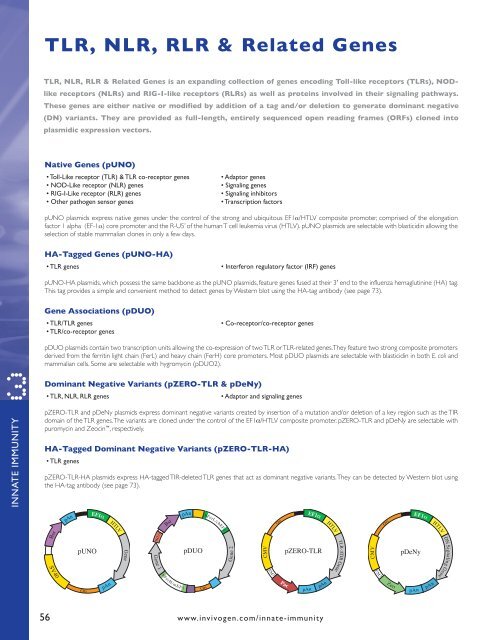scaricalo in formato PDF - labogen srl
scaricalo in formato PDF - labogen srl
scaricalo in formato PDF - labogen srl
You also want an ePaper? Increase the reach of your titles
YUMPU automatically turns print PDFs into web optimized ePapers that Google loves.
INNATE IMMUNITY 3<br />
TLR, NLR, RLR & Related Genes<br />
TLR, NLR, RLR & Related Genes is an expand<strong>in</strong>g collection of genes encod<strong>in</strong>g Toll-like receptors (TLRs), NOD-<br />
like receptors (NLRs) and RIG-I-like receptors (RLRs) as well as prote<strong>in</strong>s <strong>in</strong>volved <strong>in</strong> their signal<strong>in</strong>g pathways.<br />
These genes are either native or modified by addition of a tag and/or deletion to generate dom<strong>in</strong>ant negative<br />
(DN) variants. They are provided as full-length, entirely sequenced open read<strong>in</strong>g frames (ORFs) cloned <strong>in</strong>to<br />
plasmidic expression vectors.<br />
Native Genes (pUNO)<br />
• Toll-Like receptor (TLR) & TLR co-receptor genes • Adaptor genes<br />
• NOD-Like receptor (NLR) genes • Signal<strong>in</strong>g genes<br />
• RIG-I-Like receptor (RLR) genes • Signal<strong>in</strong>g <strong>in</strong>hibitors<br />
• Other pathogen sensor genes • Transcription factors<br />
pUNO plasmids express native genes under the control of the strong and ubiquitous EF1a/HTLV composite promoter, comprised of the elongation<br />
factor 1 alpha (EF-1a) core promoter and the R-U5’ of the human T cell leukemia virus (HTLV). pUNO plasmids are selectable with blasticid<strong>in</strong> allow<strong>in</strong>g the<br />
selection of stable mammalian clones <strong>in</strong> only a few days.<br />
HA-Tagged Genes (pUNO-HA)<br />
56<br />
• TLR genes • Interferon regulatory factor (IRF) genes<br />
pUNO-HA plasmids, which possess the same backbone as the pUNO plasmids, feature genes fused at their 3’ end to the <strong>in</strong>fluenza hemaglut<strong>in</strong><strong>in</strong>e (HA) tag.<br />
This tag provides a simple and convenient method to detect genes by Western blot us<strong>in</strong>g the HA-tag antibody (see page 73).<br />
Gene Associations (pDUO)<br />
• TLR/TLR genes • Co-receptor/co-receptor genes<br />
• TLR/co-receptor genes<br />
pDUO plasmids conta<strong>in</strong> two transcription units allow<strong>in</strong>g the co-expression of two TLR or TLR-related genes. They feature two strong composite promoters<br />
derived from the ferrit<strong>in</strong> light cha<strong>in</strong> (FerL) and heavy cha<strong>in</strong> (FerH) core promoters. Most pDUO plasmids are selectable with blasticid<strong>in</strong> <strong>in</strong> both E. coli and<br />
mammalian cells. Some are selectable with hygromyc<strong>in</strong> (pDUO2).<br />
Dom<strong>in</strong>ant Negative Variants (pZERO-TLR & pDeNy)<br />
• TLR, NLR, RLR genes • Adaptor and signal<strong>in</strong>g genes<br />
pZERO-TLR and pDeNy plasmids express dom<strong>in</strong>ant negative variants created by <strong>in</strong>sertion of a mutation and/or deletion of a key region such as the TIR<br />
doma<strong>in</strong> of the TLR genes. The variants are cloned under the control of the EF1a/HTLV composite promoter. pZERO-TLR and pDeNy are selectable with<br />
puromyc<strong>in</strong> and Zeoc<strong>in</strong> , respectively.<br />
HA-Tagged Dom<strong>in</strong>ant Negative Variants (pZERO-TLR-HA)<br />
• TLR genes<br />
pZERO-TLR-HA plasmids express HA-tagged TIR-deleted TLR genes that act as dom<strong>in</strong>ant negative variants. They can be detected by Western blot us<strong>in</strong>g<br />
the HA-tag antibody (see page 73).<br />
www.<strong>in</strong>vivogen.com/<strong>in</strong>nate-immunity


